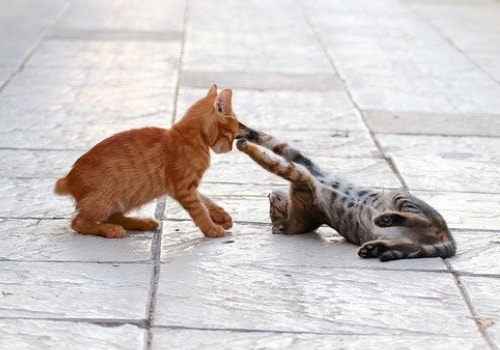Cats swat at you as a sign of play, protection, or aggression. This behavior is natural for cats and often used to communicate their mood or intention.

When a cat swats at you, try to understand their body language and the context of the situation to determine their motive. Cats are known for having complex personalities and distinctive behaviors. One behavior that can be confusing for their owners is when cats swat at them.
Cats use their paws to communicate a range of emotions, including playfulness, protection over their territory, or aggression. Understanding your cat’s body language and the situation they are in can help you determine why they are swatting at you. Some cats may simply be in a playful mood and want to initiate playtime, while others may be feeling threatened by something or someone in their environment. In this article, we will explore the different reasons behind cat swatting and how to handle this behavior.

Credit: catcheckup.com
The Anatomy Of Swatting
Cats are known for their ability to swat at objects, people, and other pets. The physical act of swatting involves the use of a cat’s claws and paws, which are specifically designed for hunting and self-defense. A cat’s paw pads are covered in sensory receptors, allowing them to feel the texture of their prey or target.
The claws are used to grasp and hold onto objects, while the actual swatting motion is achieved by extending and retracting the claws rapidly. The swatting motion is a natural reflex for cats and is often used as a form of play or to establish dominance.
Understanding the anatomy behind a cat’s swatting behavior can help cat owners better interact with their pets and prevent any potential injuries.
Reasons For Swatting
Cats can swat people for various reasons, ranging from natural instincts to playful behavior. Aggressive swatting occurs when cats feel threatened or anxious, and they react by using their claws and paws. This type of swatting can be a warning sign for humans to give cats their space.
On the other hand, playful swatting happens during playtime when cats are excited and want to play along. In such cases, the swatting may be less harmful. However, humans must be mindful to avoid any aggressive response from the cat.
Understanding the different types of swatting can help humans to control their reactions and communicate better with their feline friends. By doing so, they can cultivate a more harmonious relationship with their pets.
How To Handle Swatting Behavior
Cats are known for their occasionally aggressive behavior, specifically swatting at their owners or strangers. Understanding why your feline companion feels compelled to swat and learning how to handle this behavior are essential for a happy relationship. Different approaches to tackling swatting include using positive reinforcement, using a spray bottle or pet deterrent, and using a firm but gentle approach to disciplining your cat.
It is important to remember that cats respond best to kindness and patience, and punishment can lead to further aggression. By using safe and effective strategies for managing feline aggression, you can set the foundation for a loving and trusting relationship with your furry friend.
Signs Of Unusual Swatting Behavior
Cats are known for their unique personalities, and swatting is one of their many behaviors. However, unusual swatting behavior can signify deeper issues that require attention. Warning signs like excessive aggression, sudden attacks, and destructive behaviors should not be ignored.
Seek professional help if needed to understand and manage cat aggression. Identifying the cause of the behavior, providing proper training, and creating a safe environment are essential steps. As cat owners, we must take responsibility for our feline friends and create a harmonious relationship with them.
Remember to observe and respond to your cat’s behavior to ensure their physical and mental well-being.
Frequently Asked Questions
Why Do Cats Swat At You?
Cats may swat at you for different reasons: to get your attention, express their excitement, play, fear, or aggression.
Is It Okay To Play Rough With My Cat?
No, rough play can make a cat aggressive or timid, leading to behavioral problems. Instead, use toys to play with your cat.
How Can I Tell If My Cat Is Swatting Playfully Or In Aggression?
You can look at the cat’s body language, vocalizations, and the intensity of the swat. A playful swat may have relaxed looking ears, while one done in aggression may show flattened ears.
What Should I Do If My Cat Is Swatting In Aggression?
If your cat is swatting out of aggression, give the cat space and time to calm down. Don’t punish your cat physically.
Can Training Help My Cat Stop Swatting Aggressively?
Yes, you can use positive reinforcement training, like clicker training, to train your cat to stop swatting aggressively and use other forms of communication.
Should I Get Another Cat To Keep My Cat Company?
Getting another cat may or may not work, depending on the cats’ personalities. Consult with a veterinarian or animal behaviorist before making the decision to get another cat.
Conclusion
After investigating why cats swat at their owners, it is clear that there are several reasons for this behavior. These may range from playfulness to aggression, anxiety to territorial marking. Understanding a cat’s body language and behavior can help you identify the underlying cause of their paw swatting.
By addressing the root cause, you can begin to modify their behavior and encourage more appropriate interaction between you and your furry friend. It is important to avoid punishing your cat for swatting, as this can worsen any negative behavior.
Instead, consider providing them with enough mental and physical stimulation, such as toys or scratching posts. Remember, cats are very expressive animals, and swatting is just one way in which they communicate with us. By understanding their behavior more deeply, you can improve your bond with your feline companion and create a happier home for all.












GIPHY App Key not set. Please check settings